This page contains affiliate links. Please read our disclosure for more info.
Stromboli Island in Italy is the tip of a vast underwater volcano off the coast of Sicily.
Stromboli is Europe’s only permanently active volcano and one of the most active in the world. Watching it erupt at night is a spectacular sight.
You can view the eruption at a distance on a boat, but the best way to experience its power is to get up close on a Stromboli hike.
In this post, we share our experience hiking Stromboli, practical tips, how to get there, and where to stay.
Contents
- Stromboli Update
- Our Experience Hiking to the Stromboli Summit
- Climbing Stromboli Volcano: The Details
- Where to Stay on Stromboli Island
- How to Get to Stromboli Island
- Hiking Stromboli vs Mt Etna
- Stromboli Hike Summary
- More Sicily Posts
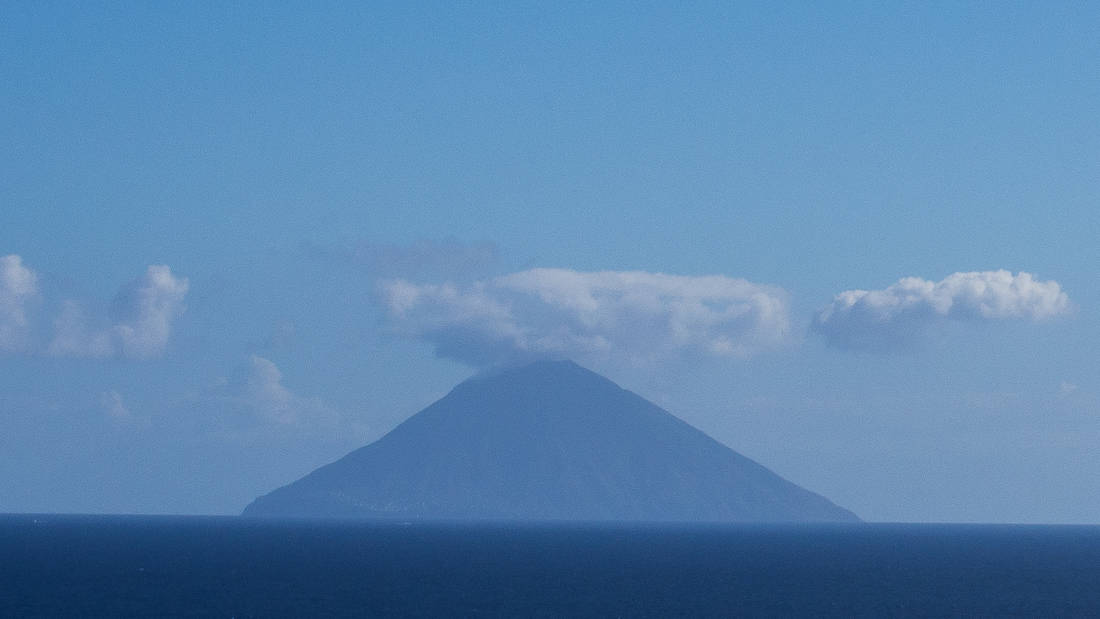
Stromboli Update
We climbed Stromboli before the major eruption in 2019. Since then, hikes to the craters at the summit, which we did, have been suspended.
The trail network has been reorganised and you can now hike Stromboli again, but the trail goes to a different viewpoint overlooking the Sciara del Fuoco (a blackened lava scar).
The highest observation point is at 400 metres and can only be reached with a guide. The 8km hike still involves a steep climb (500 metres elevation gain), but it’s not as long as the summit hike.
This Stromboli sunset hiking tour costs €30, departs two hours before sunset (usually leaving between 3-6pm), and lasts about five hours.
Even without reaching the summit, the new hike is still very much worth doing to watch the explosive show.
Our Experience Hiking to the Stromboli Summit
We began our ascent at 4pm when the hot September Sicilian sun was beginning to subside.
We left the whitewashed town (population 400) and the long black sandy beaches behind as we walked slowly up.
First it was a gentle incline through caper plants and lush vegetation, then the path became steeper and bleaker, rocks strewn amongst the grey volcanic sand.
We’d been worried about the Stromboli hike, but it was easier than we expected, taking two hours to get to the summit with frequent breaks.
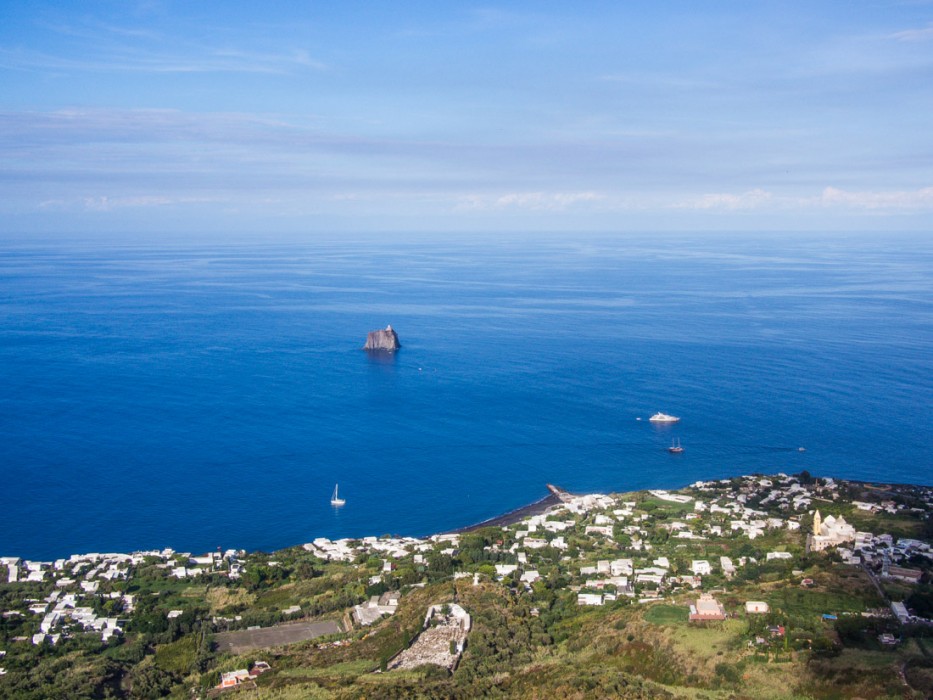
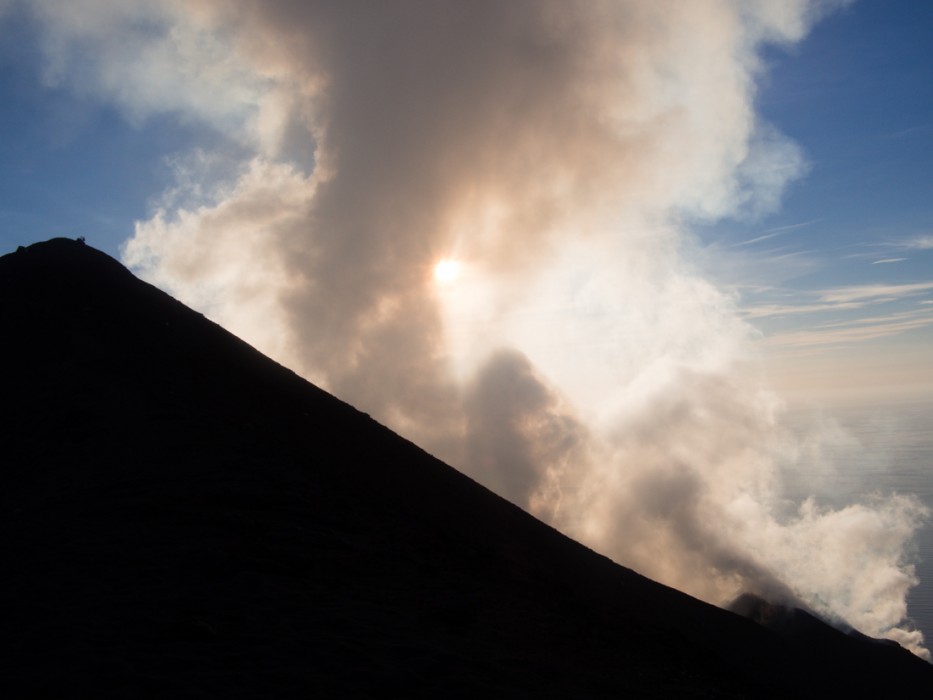
We were the first group to arrive at the three Stromboli craters, well before sunset and had plenty of time to observe their changing forms.
Clouds of smoke constantly emerged from the craters, a mass of hazy gases, at first tinted green, then orange. They made strange gushing, gurgling sounds, an ominous warning.
Part of our brains knew that waiting for a volcano to erupt so close to us was foolish, but that’s what we all craved, the chance to see the volcano showing its full power.
It tempted us with glimpses of its fiery red belly or a particularly menacing rumble, and one of the small craters expelled a cloud of black gases.
All were false starts and we continued to wait.
The sun sunk lower and the sky lit up in oranges, pinks and blues, reflected in the mirror-like sea.
Across the water we could see Calabria on Italy’s mainland, and Salina island where we’d eaten breakfast that morning, gazing over at this very peak.
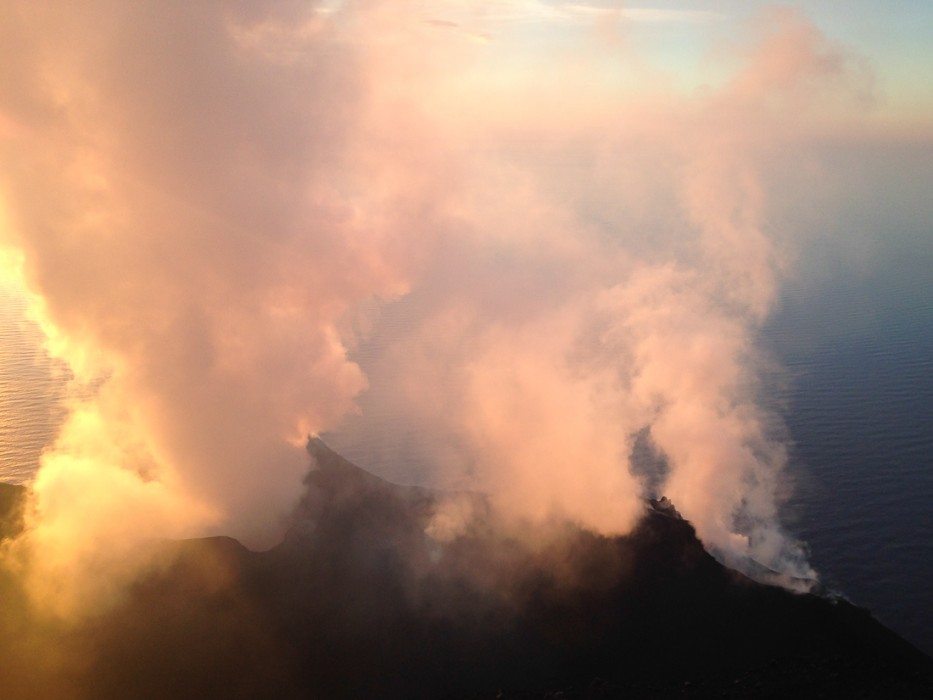
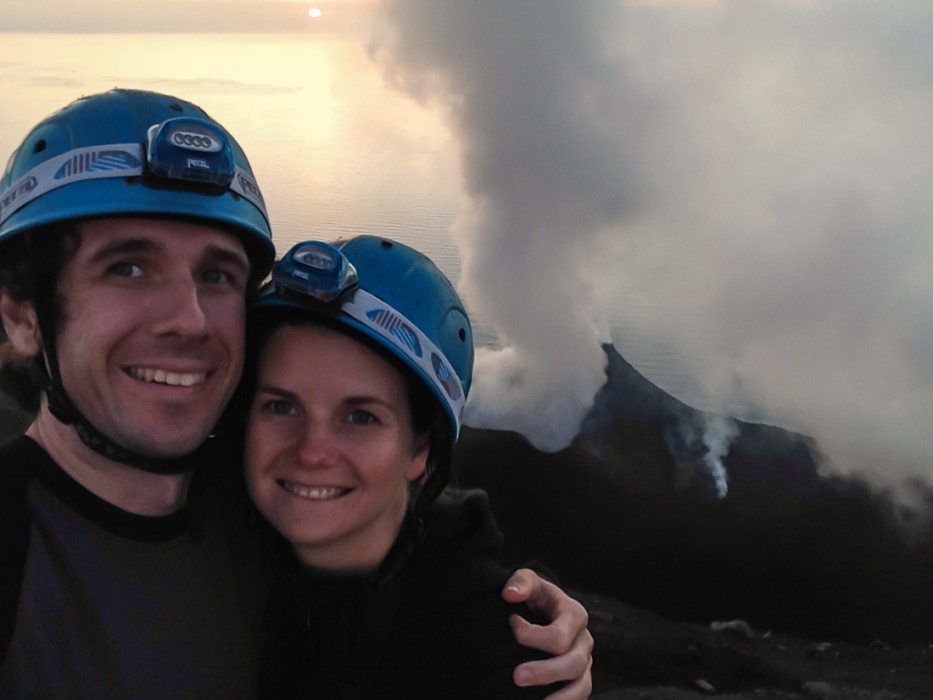
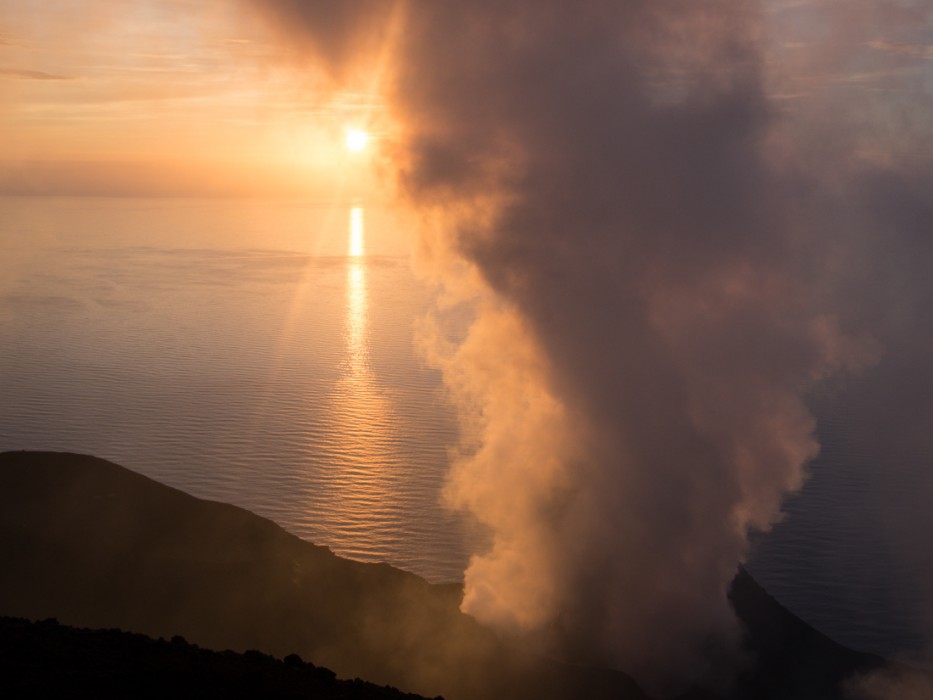
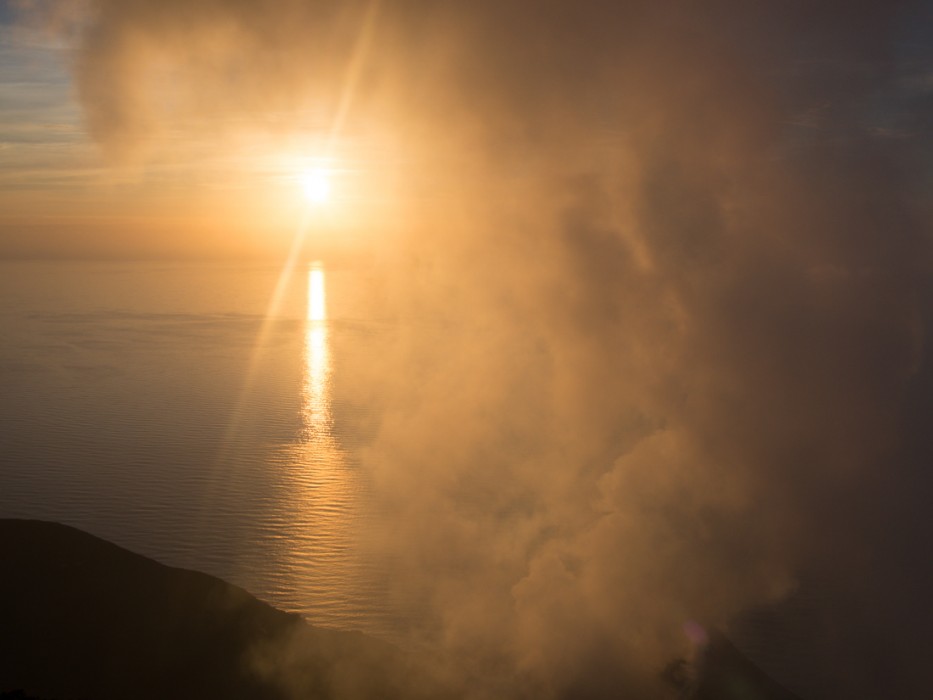
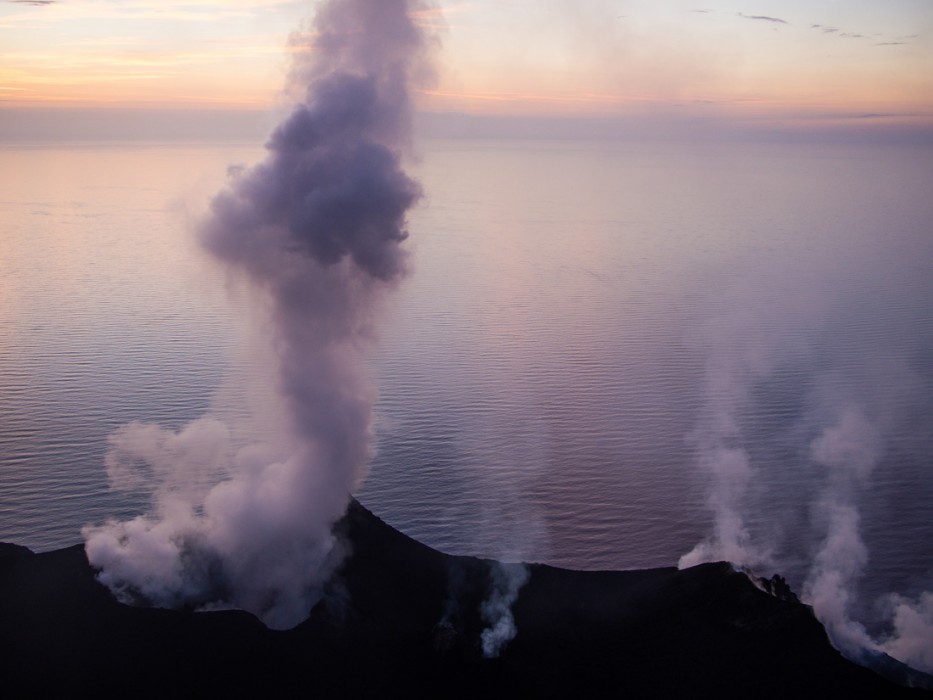
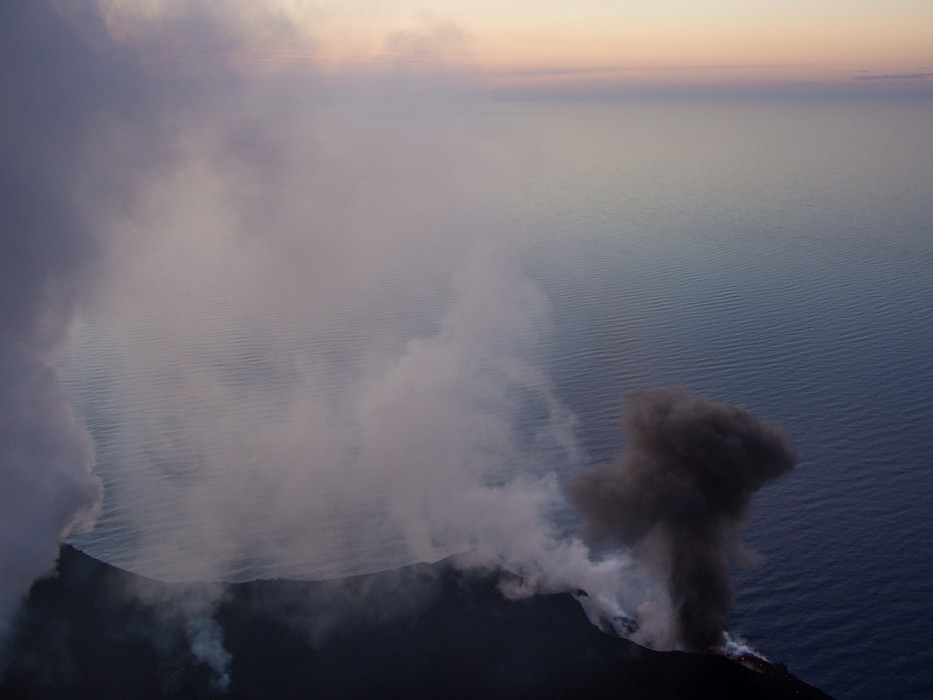
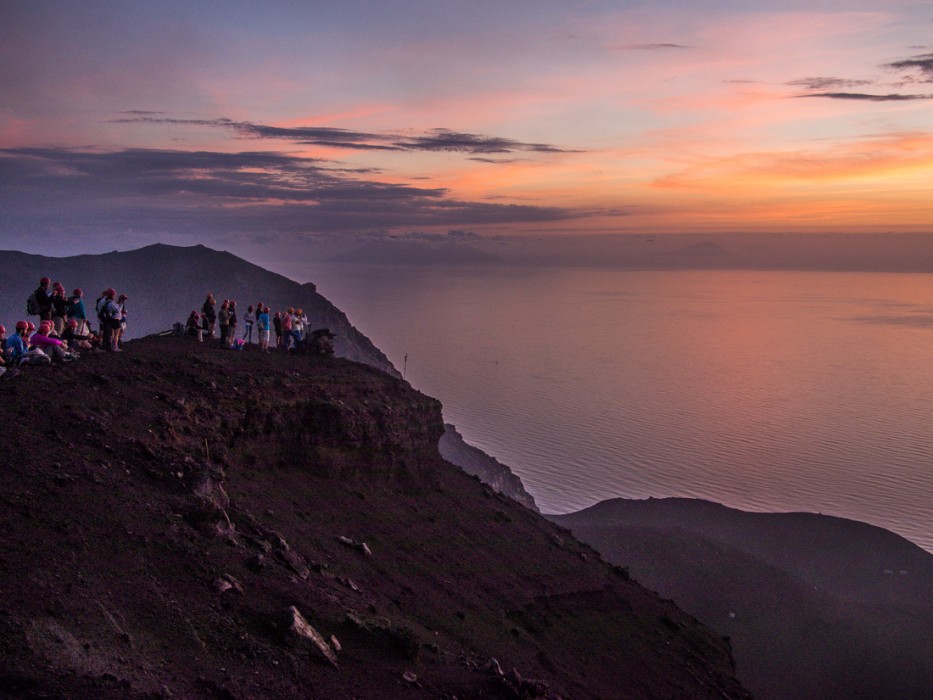
As darkness fell we finally got what we’d been waiting for.
The largest Stromboli crater erupted in a sudden burst of orange and red, sparks flying like fireworks, the red of the flames echoing the colour of the sinking sun.
It was a brief but dramatic display of nature’s might.
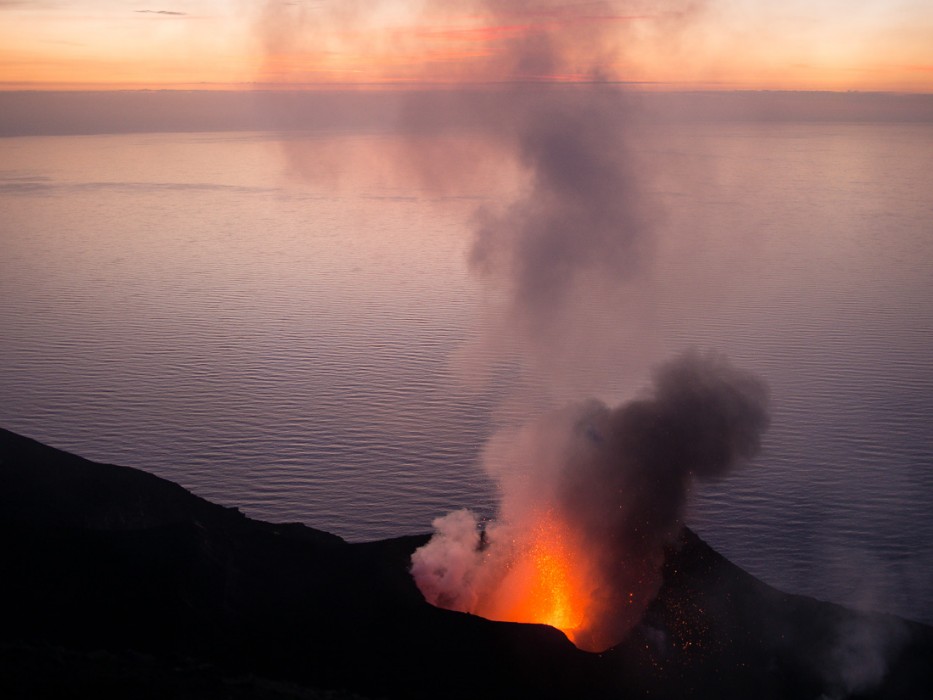
We were hooked and wanted more. We watched in silence in the darkness, in awe of its power, on tenterhooks waiting for the next eruption.
Behind us the full moon glowed large and golden, creating a strong beam of light across the sea.
Just as we prepared to depart, we were rewarded with another mini eruption—a fiery red spray from the gurgling beast.

We could have stayed all night but it was time for our group to leave.
We descended the steep slope in darkness, our headlamps illuminating the path in front but all around was blackness.
We half walked, half slid through the deep black sand, our shoes filling up with volcanic ash that would take weeks to remove all traces of.
We fell into a rhythm, taking long strides, heels first, zoning out in the silent night. It felt strange to walk on solid ground again, our legs wobbled, confused by the resistant earth.
Back in town we were too tired for a celebratory beer and pizza—a hot shower and comfortable bed beckoned.
Sunset on top of an island, a full moon hike, a volcanic eruption—any one of these would have been incredible, but all together they created a magical experience that was definitely worth the climb.
Climbing Stromboli Volcano: The Details
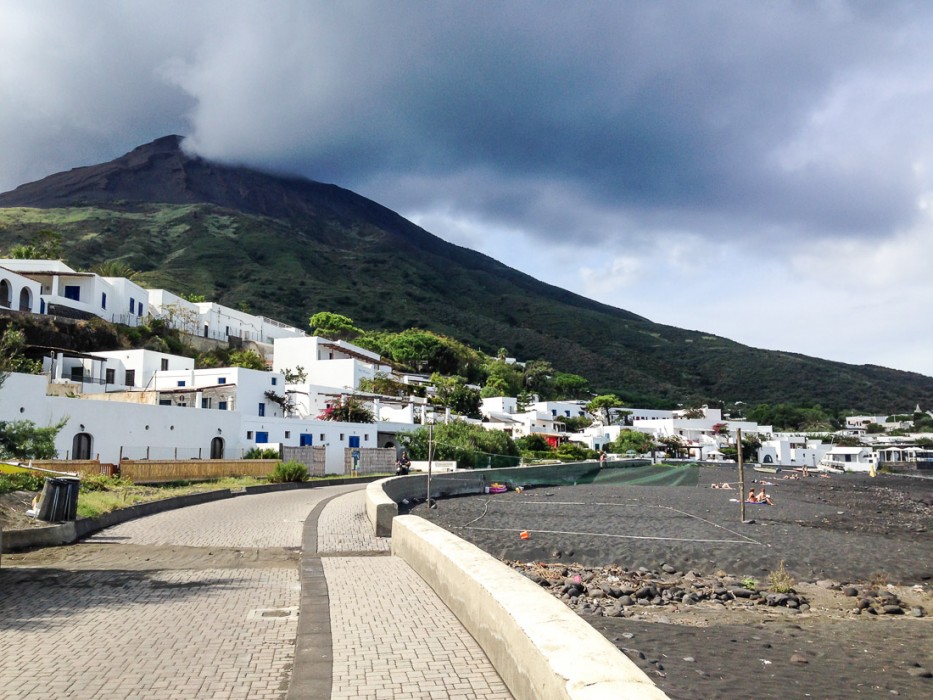
- You have to climb Stromboli volcano with a guide and most people join a group trek. We went with Magmatrek who charge €30 per person including helmets and an English speaking guide. There were 20 people in our group, so it’s not an intimate experience but all the groups were large. We were happy with the service and would go with them again.
- Ashara is another company who offer the same hike with availability on Get Your Guide. (We used them for our Etna hike).
- Booking in advance is essential.
- Stromboli tour departure times vary from 3pm to 5.30pm depending on the season. In mid September we left at 4pm and were back at 9.20pm.
- Tours run from mid March until the end of October. I would avoid trekking in July and August, if possible, because of the heat.
- Hiking shoes or boots and a torch (flashlight) are obligatory for hiking Stromboli. You can hire trekking gear from a few shops in town.
- It’s also a good idea to take snacks, water (at least 1.5 litres per person), warm clothes (it gets cold at the top), and a change of tshirt (you’ll sweat on the hot climb up).
- It’s a steep climb so you need to be reasonably fit, but it wasn’t as difficult as we thought it would be. There are breaks every 30 minutes on the way up and at least 45 minutes rest at the crater.
- The Stromboli trek is not suitable for people with asthma, a heart condition, or vertigo.
- Children must be aged over 10 years.
Where to Stay on Stromboli Island
We stayed in Residence Aquilone, which has simple bungalow rooms set in gardens.
Our small double room had a comfortable bed, private bathroom, fridge, and terrace and was just what we needed for our one night stay.
It’s one of the most affordable options on this expensive island.
Search for more places to stay on Stromboli here.
How to Get to Stromboli Island
You can get to Stromboli by ferry or hydrofoil with Liberty Lines or Siremar from Milazzo on Sicily or from the other Aeolian islands. There’s also a ferry from Naples.
We arrived from Salina island on the Liberty Lines hydrofoil, which took an hour.
If you are staying on Lipari island and want to see the Stromboli eruption at night (without hiking), you could take this Vulcano, Panarea, and Stromboli boat tour.
From Milazzo, there’s also a Panarea and Stromboli boat trip by night where you can watch the eruption.
Hiking Stromboli vs Mt Etna
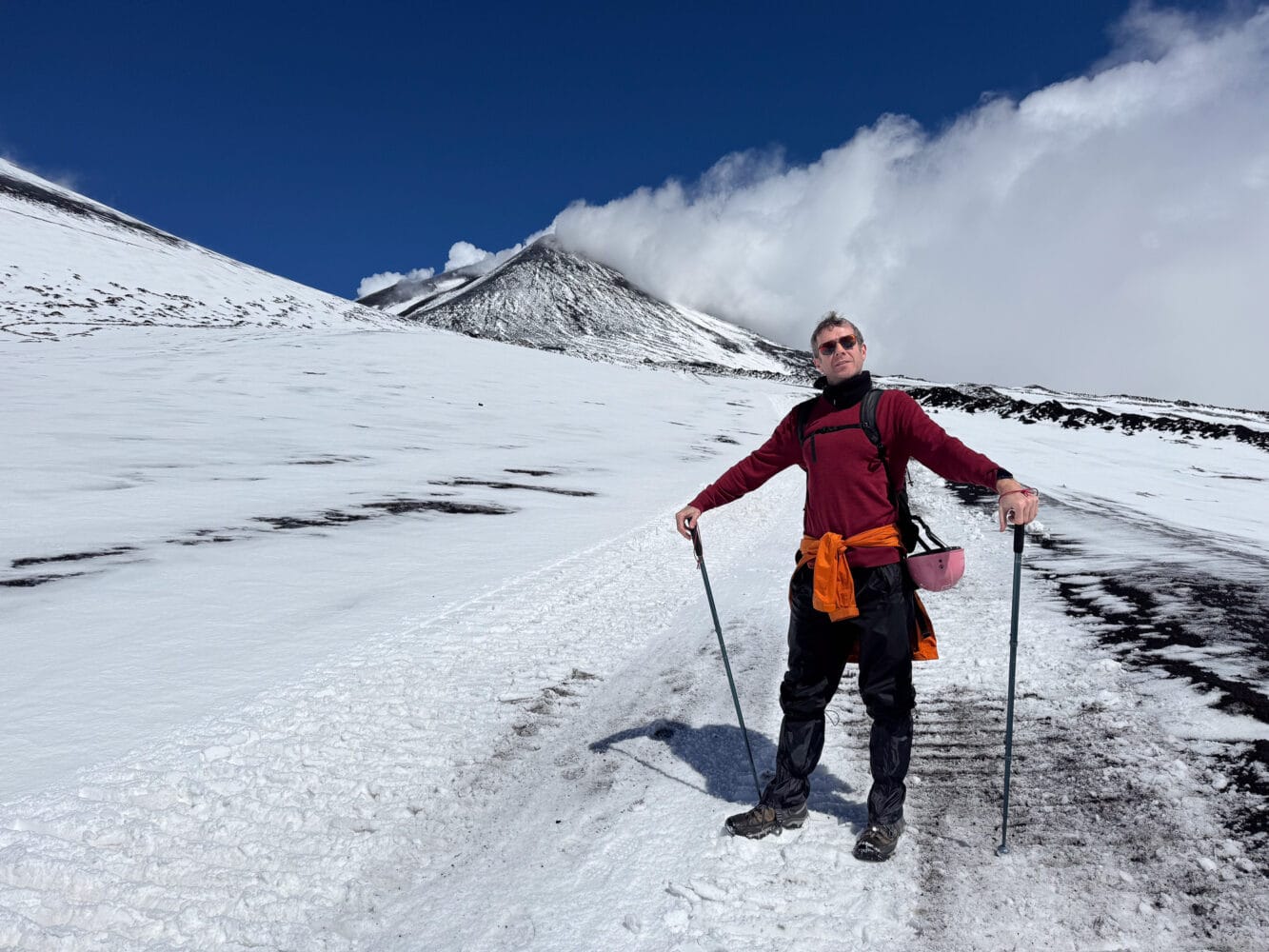
We recently returned to Sicily and hiked another iconic volcano—Mt Etna. Like at Stromboli, volcanic activity means you can no longer hike to the summit, but we went as high as you can go (a guide is necessary).
We did this Etna summit hike from 2500 metres (the top of the cable car) to 2900 metres (the highest safe point).
Both are wonderful experiences, but here are our thoughts comparing Mt Etna to Stromboli:
- Mt Etna is easier to access from Catania airport (we visited on a day trip while staying in Taormina). There’s even a limited bus service from Catania city. No ferry required. It is a long, winding road up the mountain to Rifugio Sapienza (the most common access point), though.
- Mt Etna is much larger but feels less obviously a volcano.
- Etna has a higher elevation so it gets snow in winter! We hiked through the snow in late March. The weather is much more variable and tours can be cancelled. An Etna hike in summer will be cooler than Stromboli.
- Etna hikes take place during the day, not at sunset.
- You don’t see volcanic eruptions or lava fountains on Etna, but you do see steam and craters and feel heat from vents.
- The Etna tour is more expensive plus you have to pay for a cable car to the start of the hike.
Overall, we preferred the Stromboli volcano hike because you get to see lava (if you are lucky) and being up there at sunset was magical.
Mt Etna is easier to access on the Sicily mainland, though, and you can even skip the hike and just take a cable car and 4WD bus tour to get high up on the volcano.
Our Taormina travel guide has more details on our Etna hike.
Stromboli Hike Summary
Hiking Stromboli volcano at night was one of our favourite ever travel experiences.
Even if you aren’t a super experienced hiker, we highly recommend you add it to your Sicily itinerary. It’s a magical evening.
More Sicily Posts
General
West Sicily and Aeolian Islands
- Exploring Peaceful Salina in Sicily’s Aeolian Islands
- 12 Best Places to Visit in West Sicily
- Exploring Palermo
East Sicily
- 18 Best Things to Do in Syracuse, Sicily
- The Perfect Eastern Sicily Itinerary
- 11 Wonderful Things to Do in Taormina, Sicily (including hiking Mt Etna).
If you enjoyed this post, pin it for later!
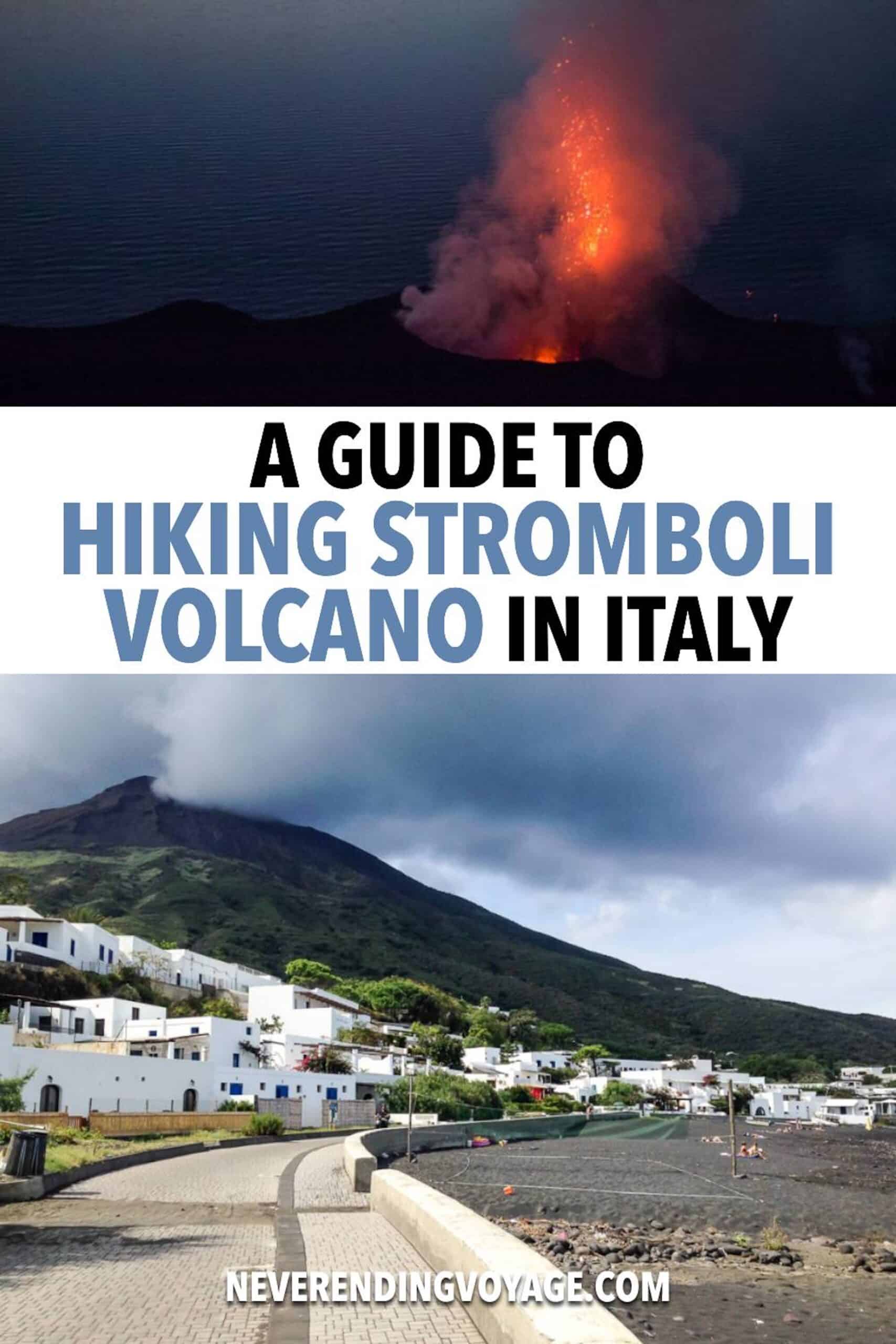
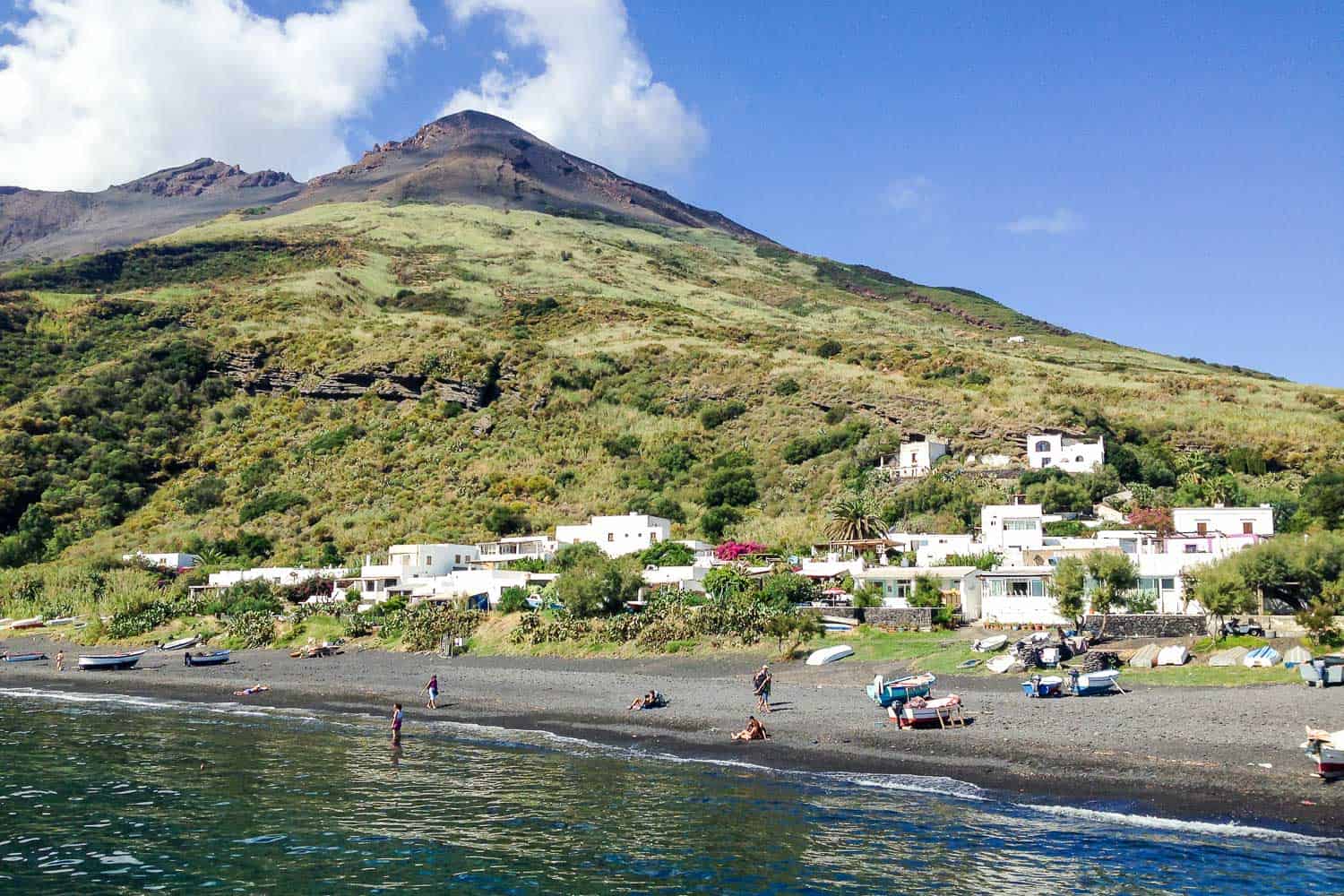
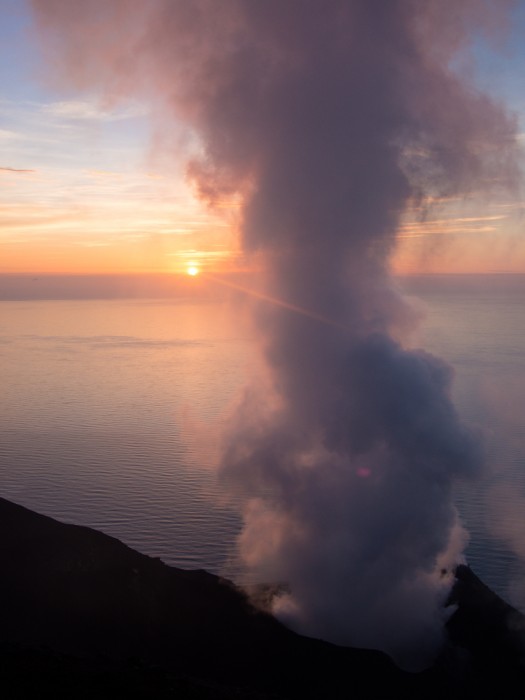
Today the islands are ruined by hordes of people. I was on Stromboli along with my Austrian friends in the 1960’s through to 1979. We and the others were in general all amateur volcanoligists. The usual few people came and went each year, all treasuring the primitive and undeveloped nature of the island.
There was harbour, no electricity, rough roads and tracks, only one track to the summit, one post office with one phone plus a shop with limited items, two pensions and no hotels, skinny dipping was common, one policeman and no guides and no health and safety, ruins of buildings was common. No medical centre along with no doctor.
I last visited the island in 2002, I arrived on the first ferry from Sicily, took one hour to look around, and decided to depart on the next ferry never to return. Paradise Lost!
Like me most of us are now too old to return, also most are now dead having first visited the island in the 1950’s. The best day are long over, waite now for news of a cholera outbreak, as there is no sewerage system.
Please reconsider when writing comments such as this on the internet.
It is apparent you have no ability to adapt or find value in things as they change, which all things do, and will end your life a sad and depressed man. Too often, senior citizens are finding that the internet is an excellent place to spew their negativity and display their often false sense that the world was “better” at some time in the past. All while making no effort to improve society. Just complaining.
I would point to the many literary works that have made a troupe of your behavior, usually cautionary tales entreating the reader to not become a spiteful, pathetic old man. You, who writes things like “the islands are ruined” despite the fact that he last visited them nearly two decades ago. Its sad what you are, but I do not pity you or hate you. I dismiss you.
Great post! When I was 11 (late 80s) with my father we climbed Stromboli. Me a child in little pumps and my dad with a big rucksack on his back, I don’t remember it being particularly hard work. We slept on the top and woke up covered in crickets. Lots of others slept on the top too. You didn’t need a guide, I saw only a handful of people let alone guides, and luckily no one got hit in the head by falling lava but we were constantly rained on by the ash after every erruption. How times have changed! We also slept on the beach but I hear that’s a no no now too…
So is it a total rule you have to have a guide to go up now? And I imagine you can’t sleep on the top any more?! I’m going back to redo the trip as an adult on my own in September, but I’m concerned my magical memories will be broken by groups, tours and guides everywhere. Looks like you had a wonderful time though!
Wow, that sounds amazing! I’m afraid it will be a totally different experience now and will be crowded at the top. You do have to go with a guide and I doubt camping is allowed, although you could check with the tour operator.
I hope you enjoy it anyway!
Thank you for all the important info, Erin. Planning a trip to the Aeolian islands in July 2020 and do this hike, myself. Pleased to see you can do a day trip to Stromboli for this hike, but I assume that wouldn’t be a night hike. I will read your other blog about Salina, since we haven’t decided whether our base island should be Salina or Lipari.
great write-up!
Nick
I think the day trips might only include viewing the eruption at sunset on the boat rather than doing the hike. It isn’t possible to hike the volcano during the day. I do think it’s worth staying overnight in Stromboli in order to do the hike.
Enjoy the islands!
Actually it is possible to do the hike as a day trip from Lipari only (not Salina) with Da Massimo.
Who did you book your hiking tour with??
The details are at the bottom of the post.
Hi!!! That is exiting!
The view looks marvelous! I wish to go there someday.
I’ve been there two years ago and the place is stunning. Kinda scary to be see and be near the smoking volcano but it was really a great experience. Happy Holidays!
Wonderful pictures, the volcanic landscapes are an inspiration.
Merry Christmas wherever you are.
This is my first time to know about Stromboli in Italy. I felt so excited when I saw your picture with a small eruption of the volcano. Such an amazing experience! Thanks for this post. I’ll surely not gonna miss Stromboli this summer.
Awesome! Isn’t it amazing (and cool) that they let you hike active volcanoes?! My Mum hiked Etna and the lava was flowing. I love volcanoes, looking forward to seeing a few in Guatemala next year and would love to see a nature show as you guys did. Happy holidays :-)
I know, it’s cool and kinda crazy :) Guatemala will be great for volcanoes. Looking forward to seeing how you get on as we want to visit at some point. Happy Christmas guys!
What an incredible experience!!!! I’m ashamed to admit that even if I’m Italian I’ve never had the pleasure to climb the Stromboli, it looks incredible!
It really did exceed every expectation and we definitely recommend it if you get the chance.
Sounds very special. Strangely, the picture I found most striking was the one of the other group of hikers. I think the contrast between the barren landscape and the and human life is what did it.
Stromboli is the one place in Italy that I regret not visiting when I lived in Europe. Have you seen Roberto Rossellini’s film with Ingrid Bergman? Great photos! Safe travels!
We haven’t seen the film but we really should. Hope you make it to Stromboli next time you’re in Europe.